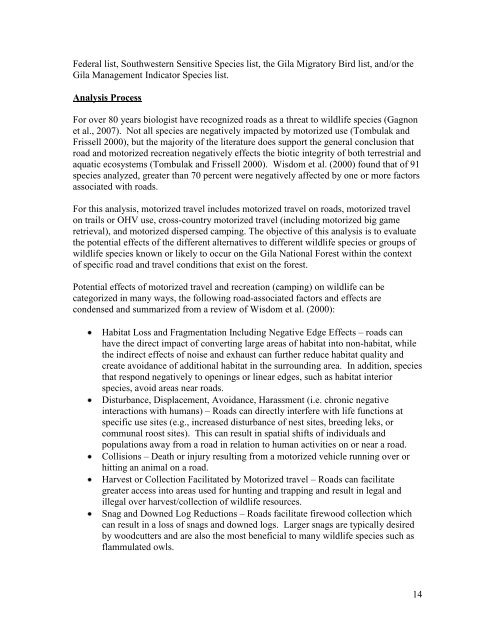Wildlife Specialist report
Wildlife Specialist report
Wildlife Specialist report
You also want an ePaper? Increase the reach of your titles
YUMPU automatically turns print PDFs into web optimized ePapers that Google loves.
Federal list, Southwestern Sensitive Species list, the Gila Migratory Bird list, and/or the<br />
Gila Management Indicator Species list.<br />
Analysis Process<br />
For over 80 years biologist have recognized roads as a threat to wildlife species (Gagnon<br />
et al., 2007). Not all species are negatively impacted by motorized use (Tombulak and<br />
Frissell 2000), but the majority of the literature does support the general conclusion that<br />
road and motorized recreation negatively effects the biotic integrity of both terrestrial and<br />
aquatic ecosystems (Tombulak and Frissell 2000). Wisdom et al. (2000) found that of 91<br />
species analyzed, greater than 70 percent were negatively affected by one or more factors<br />
associated with roads.<br />
For this analysis, motorized travel includes motorized travel on roads, motorized travel<br />
on trails or OHV use, cross-country motorized travel (including motorized big game<br />
retrieval), and motorized dispersed camping. The objective of this analysis is to evaluate<br />
the potential effects of the different alternatives to different wildlife species or groups of<br />
wildlife species known or likely to occur on the Gila National Forest within the context<br />
of specific road and travel conditions that exist on the forest.<br />
Potential effects of motorized travel and recreation (camping) on wildlife can be<br />
categorized in many ways, the following road-associated factors and effects are<br />
condensed and summarized from a review of Wisdom et al. (2000):<br />
Habitat Loss and Fragmentation Including Negative Edge Effects – roads can<br />
have the direct impact of converting large areas of habitat into non-habitat, while<br />
the indirect effects of noise and exhaust can further reduce habitat quality and<br />
create avoidance of additional habitat in the surrounding area. In addition, species<br />
that respond negatively to openings or linear edges, such as habitat interior<br />
species, avoid areas near roads.<br />
Disturbance, Displacement, Avoidance, Harassment (i.e. chronic negative<br />
interactions with humans) – Roads can directly interfere with life functions at<br />
specific use sites (e.g., increased disturbance of nest sites, breeding leks, or<br />
communal roost sites). This can result in spatial shifts of individuals and<br />
populations away from a road in relation to human activities on or near a road.<br />
Collisions – Death or injury resulting from a motorized vehicle running over or<br />
hitting an animal on a road.<br />
Harvest or Collection Facilitated by Motorized travel – Roads can facilitate<br />
greater access into areas used for hunting and trapping and result in legal and<br />
illegal over harvest/collection of wildlife resources.<br />
Snag and Downed Log Reductions – Roads facilitate firewood collection which<br />
can result in a loss of snags and downed logs. Larger snags are typically desired<br />
by woodcutters and are also the most beneficial to many wildlife species such as<br />
flammulated owls.<br />
14
















